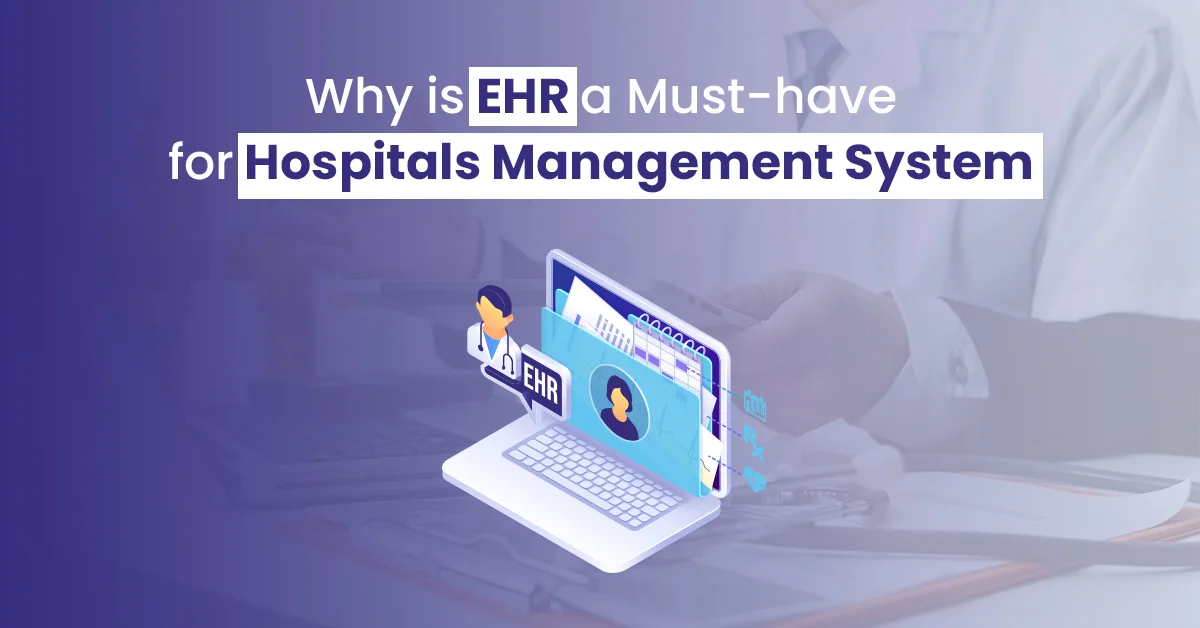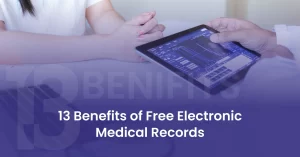Paper records are obsolete. They were error-prone, difficult to retrieve, and led to delayed treatments. Electronic health records (EHRs) have improved patient information management in hospitals, leading to better coordination and healthcare results. This blog examines the core functions of EHRs and why an EHR is so important in the healthcare field or any hospital management system.
An EHR is a healthcare management software for digitizing a patient’s medical chart. It is a digital record of the provider’s medical services offered to his patients. Compared to paper records, EHR is considered more efficient, effective, and accessible to patients and medical staff. The medical information could be chart notes, patient history, diagnostic results, and allergies. It allows medical information to be shared among all entities involved in patient care.
How Does EHR Software Function In The Healthcare Facility?
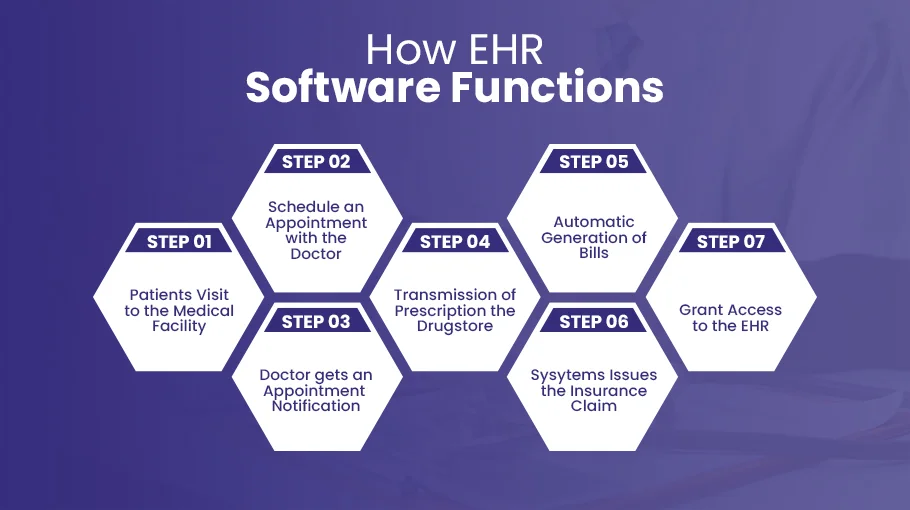
Electronic Health Records or EHR system helps hospitals and doctors keep all the important medical information in one place – from when a patient first registers to the billing staff to keeping track of a patient’s treatment plans. So, let’s check out how this EHR software works step-by-step in a healthcare facility:
Step #1: The patient registers and gains access to medical information.
Upon arrival, the patient provides information about their medical history and other specific conditions, such as allergies, surgeries, etc. The EHR then provides the patient with access to their online medical account, where they can view all of their medical information, such as appointments, prescriptions, and visits.
Step #2: The receptionist schedules the visit and checks availability.
The front desk receptionist schedules a visit with the doctor using the scheduling tool. It automatically synchronizes with the doctor’s schedule to check the available slot.
Step #3: The doctor receives the notification and documents the diagnosis.
The doctor receives an appointment notification and reviews the patient’s specific information in an electronic chart. Following the visit, the doctor enters the diagnosis, a step-by-step plan for future activities, and prescriptions into the digital record.
Step #4: The EHR system transfers and fulfills the prescription.
The EHR system transfers the prescription to the drugstore, where the order is assembled and completed before the patient arrives.
Step #5: The system automatically generates patient bills.
The system then automatically generates the bills, which are handed over to the patient through the financial department.
Step #6: The EHR generates the insurance claim for submission.
The system generates the insurance claim, ensuring that its format corresponds to the requirements of the patient’s insurance provider.
Step #7: Patients grant EHR access for lab tests, and doctors view results.
Patients can grant access to the EHR if they need to submit lab tests. A doctor can also view the test results upon request.
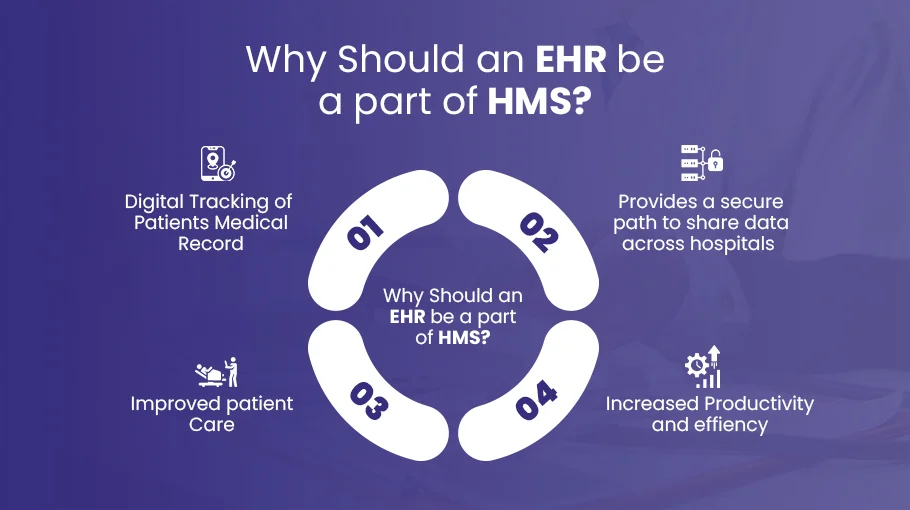
The Core Functionalities Of An EHR In The Hospital Management System (HMS)
While a Healthcare Management System (HMS) is an excellent solution for enhancing a hospital’s overall efficiency, integrating EHR makes it even better. Here are some reasons why an EHR should be a part of HMS.
EHR enhances tracking efficiency
Hospitals collect vast amounts of patient data daily, which is complex and prone to error when handled manually. Computerized records keep track of the most recent medical data efficiently, reducing paperwork and storage concerns.
EHR enables advanced data sharing
EHRs are vital in hospital data management, especially when multiple doctors treat a patient together. They allow secure data sharing among physicians, hospital branches, and even patients, facilitating real-time collaboration and quick decision-making for the best medical outcomes.
EHR optimizes diagnosis and patient engagement
Integrating EMR and EHR software enhances diagnosis, and improves patient outcomes with quick access to accurate medical data. They assist in managing health concerns through automatic reminders for tests, and appointments. Additionally, they enable seamless patient-doctor communication for better engagement and satisfaction.
EHR maximizes efficiency through integration with Practice Management System
Coupling EHR and Practice Management System (PMS) improves efficiency in hospitals. Centralized info management eliminates redundant paperwork, speeds up access to records, and improves accuracy. This increases productivity and efficiency.
EHR empowers predictive analytics
Electronic Health Record (EHR) software empowers predictive analytics in healthcare by collecting and storing patient data in a single, secure location. This data can then be used to identify patterns and trends, which can help providers make more informed decisions about patient care. For example, EHR data can be used to predict which patients are at risk for developing certain conditions, or which patients are most likely to respond to a particular treatment. This information can then be used to develop targeted prevention and treatment plans. Additionally, EHR data can be used to track the effectiveness of healthcare interventions, which can help providers improve the quality of care they provide.
Impact of EHR on the Hospital Management System
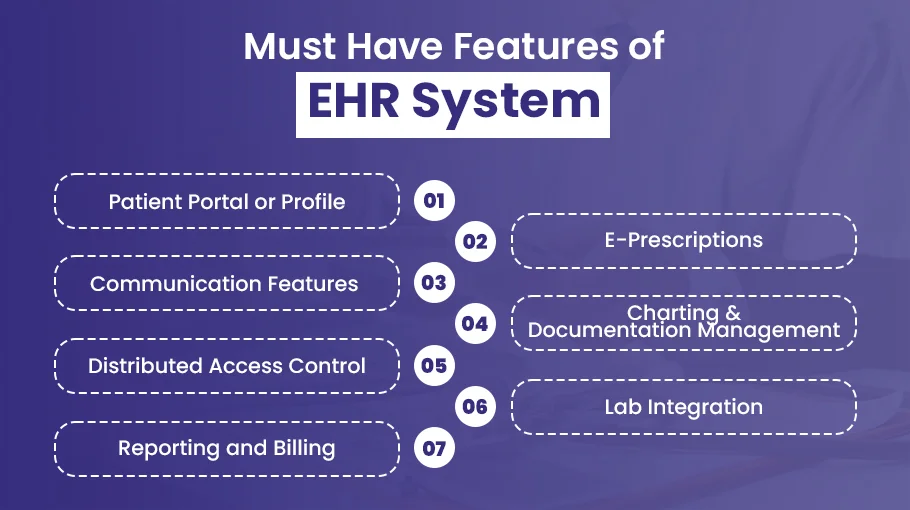
Electronic Health Records act as digital folders, holding essential data about patients and enabling quick access to their medical history. Here are the factors that tell how EHR improves healthcare in the hospital management system.
Quick and Efficient Patient Care
EHRs are like special digital folders that hold all the important information about a patient. EHRs are so handy because they allow doctors and nurses to quickly find patient data in the hospital. This makes it much easier for them to take care of you!
For instance, when a doctor needs to figure out what might be wrong with a patient, they can look at their medical history in the EHR. This helps them make a diagnosis faster. And guess what? Nurses can also use EHRs to see what medicines a patient needs before giving any treatment.
Using EHRs helps the hospital team work better together, leading to faster and better care for patients. No more waiting around for decisions – everything is right there in the EHR, making things run smoothly.
Teamwork for Better Health
Have you ever wondered how doctors and nurses remember everything about a patient’s health? Well, they have something super cool called Electronic Health Records (EHRs)! These are like special files that have all the important info about a patient.
EHRs are like superheroes because they give all the healthcare team members access to the patient’s medical history. It’s like a big puzzle that comes together and helps everyone work together better!
Imagine a patient comes to the hospital with a new health problem. No worries! The EHR is super smart and quickly tells the doctors if the patient is allergic to any medicines. This way, they can give the right treatment without any worries.
Using EHRs helps doctors, nurses, and everyone on the team take better care of you. It’s like having a secret book that holds all the important stuff about your health! So, you can feel safe and trust that everyone is working together to make you feel better.
Smooth Information Sharing
EHRs are like superhero folders that hold all the important information about patients. They make hospitals work even better.
With EHRs, all the patient data is kept in one place, like a secret headquarters. This helps the hospital team easily know what’s going on with a patient. They can quickly see how the patient is doing and what treatments are needed.
And here’s the coolest part!
If many specialists are taking care of a patient, they can all share their notes and plans using the EHR. It’s like the superheroes teaming up to save the day. EHRs make sure everyone is on the same page and can work together to give the best care possible. So, the hospital runs smoothly and patients get the amazing care they need.
Seamless Care Across Different Places
EHRs are like magic helpers for hospitals. They make it easier for different healthcare organizations to talk to each other and share information about patients. This is called “interoperability.” It helps keep the care going smoothly when patients move from one place to another.
For instance, if someone leaves the hospital, their important medical information from the EHR can be sent to their regular doctor. This way, the doctor knows all about what happened at the hospital and can take good care of the patient afterward. EHRs make sure everyone is on the same page and helps give patients the best care possible.
Efficient Use of Time and Resources
EHRs make things run smoothly and help manage resources better. EHRs can do things automatically, like scheduling appointments and ordering tests, which means the hospital staff has more time to take care of patients. This is good because it lets the doctors and nurses focus on giving good care quickly. EHRs can also keep track of things like medicines and supplies. This helps the hospital know what they have and when they need more. So, the hospital won’t run out of important things when they are needed.
Saving Time and Money
EHRs are able to increase hospitals’ efficiency and cut expenses. EHRs, for example, can help reduce the number of duplicate tests ordered. This can save hospitals money while also improving care quality. Furthermore, EHRs can aid in the reduction of drug mistakes.
Avoiding Mistakes with Medicines
EHRs are super important in stopping medication mistakes. They use special tools and notifications to help healthcare professionals. With EHRs, doctors get alerts about possible drug problems, so they can make smart choices when prescribing medicines. These alerts also remind doctors to do important tests, making sure patients get the right and safe medications. EHRs make it easier for doctors to keep patients safe and avoid errors with medicines.
FAQs
What are the must-have features of an EHR system?
1. Patient Portal or Profile: A secure portal that allows patients to access their medical information and communicate with healthcare providers.
2. E-prescriptions: Enables electronic prescription requests and eliminates errors in dosage and instructions.
3. Communication Feature: Facilitates direct and secure communication between patients and healthcare teams.
4. Charting and Documentation Management: Provides comprehensive and legally binding records of patient interactions, conditions, and treatments.
5. Distributed Access Control: Ensures sensitive health data is only accessible to authorized users through role-based access control.
6. Lab Integration: Seamless integration with medical laboratories for efficient tracking and receipt of test data.
7. Reporting and Billing: Includes effective reporting and billing management modules to enhance system performance.
8. HIPAA Compliance: Ensures the system meets the security and privacy standards set by HIPAA.
How to choose an EHR system?
Consider your needs, priorities, goals, and requirements to select the right EHR system. Evaluate aspects like cost, ease of use, integration with other systems, and implementation process.
What’s the distinction between EHR and EMR systems?
EMR is a computerized record of a patient’s medical history from a single practice, while EHR contains data from multiple providers.
Who makes use of EHR systems?
EHR systems are commonly used by doctors and hospitals to store, record, and share patient data. They are also utilized in laboratories, emergency rooms, clinics, medical imaging facilities, and pharmacies.
How do you get into the EHR System?
Most EHR systems are compatible with PCs and mobile/tablet devices. They offer user-friendly apps for mobile phones and tablets.
